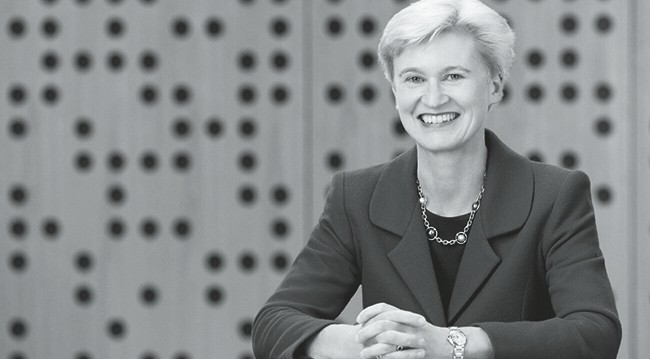With the release of AICD and USYD Business School's innovation research, leading directors share ways innovation helped their organisation prepare for the future.
Of the many risks boards and directors must consider, innovation is perhaps the most slippery. Invest in innovation and you risk failure; fail to invest in innovation and you risk annihilation. “The clever board doesn’t just increase risk, but takes a calculated look at risk,” says ANZ chair David Gonski AC FAICDLife.
Competition now comes from every quarter, every country. Internet-charged startups can disrupt decades-old business behemoths. Research from universities swiftly blooms as fully fledged and venture-backed products and services. Global giants open virtual or physical operations and the competitive playing field is upended overnight.
Pioneering research conducted by the AICD in association with the University of Sydney Business School reveals that although three quarters of directors say their organisation has an innovation vision or that innovation features in their strategic plan, far fewer have innovation as a regular board agenda item. There is also a distinct paucity of innovation-focused board committees.
While the report, Driving Innovation: The Boardroom Gap, does reveal innovation is an ongoing agenda item in 39 per cent of the nation’s boardrooms, it clearly identifies a big blind spot for boards. In short, a significant gap has emerged between innovation strategy formulation and its implementation. Consequently, Australian organisations are falling behind their overseas peers and underestimating the strategic risk of innovation that is too slow, too restrained or just absent.
Australian Bureau of Statistics data reveals almost half of Australian businesses are undertaking innovation — but the nation’s R&D intensity is below the OECD average. And when directors were quizzed by the AICD research about their own organisation’s investment, 57 per cent did not know how much they spend on R&D.
Kee Wong FAICD, chair of the technology governance and innovation panel of the AICD, notes that as a small nation that for a long time has relied on natural resources, Australia’s future as a society is innovation. “We have no other tool for the future apart from literally being a clever country and also one in which innovation is something where we differentiate ourselves on a global scale,” he says.

Currently just three per cent of directors say they have science and technology expertise, or international expertise. According to Wong, “Every director has the responsibility to educate themselves and understand the difference between transformative innovation, maintenance innovation — business as usual but faster, at a lower cost — to innovation that is transformative and disruptive.”
Directors also acknowledged the need for an innovation lens to be applied across all board agenda items. Rising global competition and the advent of the fourth industrial revolution, which is being turbocharged by technologies such as the internet, cloud computing, robotics and artificial intelligence (AI) will inevitably have an impact on every enterprise — and also its workforce. Directors need to be prepared to grapple with the implications of that for their employees and their balance sheet. Their overseas peers are preparing.
Driving Innovation
The AICD and University of Sydney Business School collaborated on the study, comprising a survey of 658 members, interviews with directors and chairs, and a review to compare Australian directors with their international counterparts. The University of Sydney team was led by Dr Massimo Garbuio. The study found:
Australian directors recognise the importance of innovation, but more needs to be done to prioritise its delivery.
Australian boardrooms have low innovation and digital literacy levels.
Board-executive collaboration leads to better performance.
The Spring 2019 MIT Sloan Management Review reveals that in a study of more than 1200 publicly traded companies with revenues above US$1 billion, 24 per cent had “digitally savvy” boards. Driving Innovation notes that: “Those businesses with digitally savvy board members significantly outperformed others on key metrics such as revenue growth, return on assets and market cap growth. Interestingly, a cohort of at least three digitally savvy directors was needed to have an impact on performance.”
Reflecting a growing awareness of the need for more diverse boards, in a 2019 SpencerStuart survey of 113 US nominating/governance committee members, 34 per cent of respondents identified technology experience as a top priority for board recruitment (second highest priority after female directors, 36 per cent). While looking ahead to the next three years, 38 per cent of respondents nominated technology experience (overall second highest priority after female directors, 40 per cent) and 35 per cent digital/ social media experience (fourth highest priority overall).
In Australia, only one in 10 directors say they provide innovation, product development and R&D expertise to their organisation. Access to skills was identified by survey respondents (31 per cent) as a brake on innovation, as was funding (28 per cent)the focus on short-term financial results (19 per cent),as well as lack of urgency (10 per cent). Lack of board or executive support was cited by only four per cent of respondents.
However, directors seem to be focused on mid-term innovation impact instead of the frequently advocated three-horizons framework, which spreads resources 70:20:10 on core, adjacent and transformational innovation efforts. Only four per cent claimed a focus on innovation impacts six to 10 years hence.
Angus Armour FAICD, MD and CEO of the AICD, says although boards do understand innovation is important, they feel they are not following through on implementation with the same frequency as they address other issues such as compliance. “That is a significant concern for individual firms and institutions,” he says. “It means their focus is not as strong as it has to be and from the perspective of our economy, we are not as productive as we need to be. Productivity has been in decline, and GDP per capita has been flat or declining. These are all indicators of a less resilient economy. Our innovation performance globally is not at the level we need it to be.”
He stresses doing nothing is not an option. “You have to look at productivity performance, at our global rankings, to realise doing nothing means a lower level of prosperity in 10 years’ time compared to where we are now.”
75% say their organisation has an innovation vision or it features in the strategic plan
57% do not know how much their organisation spends on R&D and innovation
Armour calls on directors to learn the language of innovation, to have conversations with investors and staff about the need for innovation, and to help foster a culture allowing an organisation to innovate, thrive and compete. Having started the conversation, directors also need to follow through, he stresses, checking in with management to track innovation progress and ensure it is being properly rewarded.
He also advocates for innovation to be formally placed on an organisation’s risk register, noting that the implications of innovation will vary from company to company, sector by sector. “It’s important the risk register captures two different risks — the risk if we do and the risk if we don’t. It’s also important not to put innovation in a glass case somewhere and reflect on it from time to time. It must be an integral part of strategy and business every day.”
As the report states, “The greatest contribution the board can make to building a more innovative organisational culture is by prioritising the issue and holding the executive to account on delivery.”
Case studies – Ready to Hatch

Recognising it was lacking the strategy, funding, process and governance to realise its innovation ambitions, Mirvac established its Hatch initiative in 2014. Five years on, the property giant wins accolades as one of Australia’s most innovative companies. It now works with French consultancy INCO, which helped set up Mirvac’s Impact Accelerator.
According to Christine Gilroy, Mirvac group general manager innovation, the board has played a pivotal role in crafting the strategy, creating a culture of innovation backed by design thinking and setting aside a protected innovation fund.
“We are creating an ambidextrous organisation so we can continue to exploit our current business, with incremental innovation and then big game-changing disruptive innovation,” she says.
Mirvac director Christine Bartlett MAICD says the biggest benefit comes from directors and executives sharing innovation experience.
“It’s a mistake just to do it with the board. NAB did one [where] the board went but the executive team didn’t. The board came back and started asking all these questions and the executive team had no context.”
She notes innovation must be a perennial agenda item. “I don’t know any company I’m on that doesn’t have disruption as one of the risks on the risk register. Disruption is the risk and innovation is the opportunity. No company can afford not to be doing this because the pace of change is just so intense that you need to have your radar up. If you don’t do it to yourself, someone else will do it to you.”
According to Gilroy, “We have been able to deliver what we took to the board. They were patient because it took a long time in that first year or two to really crank up the engine and upskill the people. Now there is so much momentum that the patience of the board is paying dividends. In the early years, there weren’t tangible results. It was a journey of faith, but I always felt the board was with us.”
Gilroy presents to the board twice yearly, and individual directors regularly make ad hoc visits to Mirvac’s innovation space and get involved with individual projects. “We have an idea at the moment: a new housing typology for young people,” she says. “We had one of our board members make introductions to expert people in that area.”
Bartlett has a background in IT and finance. She attends tech company summits, has visited Silicon Valley, Seattle, China and Singapore, and in July, led a trade delegation to Israel.
“Directors have a responsibility to keep themselves current, to be inquisitive and curious, and find ways to build their knowledge and skills,” she says. “Some of my colleagues have done things like Singularity University to stretch their thoughts and insights, and to challenge them about how they are thinking.”
“If you are not trying things that have not worked, then you are not innovating,” adds Gilroy.
Winning feeling
When John Winning launched Appliances Online, his father didn’t believe it would work and didn’t want the family name associated with the venture. However, he did want to give his son and his innovative idea a go.
It did work, and John Winning is now CEO and director of Winning Group — and is as committed to innovation as he was then.
A family owned and run company, Winning operates under an advisory board structure. “All three directors have, for the last 40 years, only worked for one company. To give us diversity, we have to have an advisory board.”
Winning doesn’t expect the advisory board to come up with innovative ideas, but he does expect it to be open to them — and augment the innovation insights available to family directors. Besides Appliances Online, Winning Group also now has a logistics company, an installation business, premium lifestyle magazine and a software company called Heelix.
It’s the advisory board that grounds Winning. “When I have my head in the clouds they grab my ankles and drag me back. They make sure the day-to-day stays stable, but are not against doing some really interesting things.”
Making waves
Daniel Shaddock is a professor in physics at the Australian National University and CEO and co-founder of Liquid Instruments. The startup is leveraging the science of gravitational wave detection in an attempt to disrupt the multibillion-dollar global test and measurement market. Innovation is the company’s lifeblood and directors must understand that, he says.
Instead of focusing on extracting maximum revenue from the first disruptive product Liquid Instruments launched, directors have had to adjust to a company geared for continuous innovation.
New directors joined the company following a US$8.16m investment round led by Washington DC based Anzu Partners, which also saw the Canberra business flip to become a US operating company. The directors — some US, some Australian — make a pretty good mix, says Shaddock. “We have some who understand what we have today will pale in comparison. The silver lining is when directors step down, we don’t lose their insight. Former board members are almost as valuable as current board members if the relationship is strong. We’re collecting a brains trust as the company grows.”

Top three barriers to innovation
- Access to talent 31%
- Access to financial resources 28%
- Short-term focus 19%
Five vital steps
- Lift directors’ technology and digital literacy. Innovation requires a clear mindset and focus. It also requires shared experiences among board members rather than allocating responsibility to a “tech” person on the board. It is each director’s responsibility to make informed decisions on the proposals put forward by the executive, and, where necessary, to lift their level of digital and technological literacy. Directors do not need to be technical experts, but they must be able to understand how key technological developments will impact their business. Innovation should form part of directors’ program of continuing education.
- Set clear expectations of management regarding calculated risk-taking to drive innovation.
- Develop a shared language with management, and clear narrative for investors/members on innovation. Directors and management should clearly distinguish incremental innovation from disruptive innovation. Growth is generated by innovation but it requires acceptance of risk-taking. Directors should support management in balancing continuous improvements to current processes and products, while also investing in products and services that will become available in a five to 10-year horizon. Agreed language and a clear narrative will set expectations for the executive team, broader workforce, members/shareholders and other stakeholders.
- Ensure innovation features regularly on boardroom agendas. Boards should assess how their innovation strategy is being realised and what are the key obstacles to implementation. Having regular conversations on innovation via periodic agenda items can help make innovation a more mainstream boardroom topic. Governance arrangements should be reviewed to determine whether formal board committee or advisory panel structures, drawing on outside experts, would help organisations achieve their innovation goals.
- Establish a budget and executive incentives for long-term innovation. If innovation is to become a priority, boards need to assign time and a budget for it. This assists the executive team to prioritise initiatives and offer regular visibility of innovation projects. Similarly, performance and remuneration frameworks need to be recalibrated so innovation, including innovation with longer horizons, is encouraged within the organisation.
Shifting gears
The RAC in Western Australia’s 12-year journey to create a board and management culture of innovation saw it dramatically improve its performance.

The RAC in WA’s CEO of 21 years, Terry Agnew FAICD, retired in March and is now chair of the Business Council of Co-operatives and Mutuals. He outlines some lessons boards must heed in order to more effectively drive change.
Is there value in creating board sub-committees responsible for innovation?
In my view, no. A key success factor with innovation is collaboration — internally, between board and management, as well as externally. The risk of establishing sub-committees is that it creates further pockets or silos that are the enemy of collaboration. There is much more value in the whole board participating in innovation engagement and dialogue.
One of the challenges for any board is that the regular board meetings are frequently crowded with agenda items. This can limit the time available for dialogue and therefore often results in the innovation agenda item being more around presentations or reports.
Strategy retreats, by nature, are a valuable forum but the real opportunity gap to close is for stronger engagement between board and management. This should extend to the nature of innovation, what an innovative environment looks like and the challenges of innovation, including “failures”.
Boards need good processes and frameworks around innovation, but it is also important to spend time discussing the metrics and why they are appropriate. This enhances greater common understanding and engagement in the innovation process and the sort of environment that best facilitates innovation.
The board and executive response when innovation initiatives fail is also important. At both levels it is valuable to spend time discussing and understanding failures and, in particular, what management and board can learn from them.
Another important question: is your board sending a clear message — both verbally and behaviourally — to management about the need to be bold in reimagining the business and moving to a new future?
What would I do differently if I had my time again?
Find a way to establish more dialogue around innovation — between management and board, as well as between senior leaders.
Establish broader links to the external innovation community.
Recruit more external innovation “coaches” earlier. They should have specific experience in various aspects of innovation.
The RAC in WA Innovation and Culture Change Journey case study can be obtained by emailing innovation@rac.com.au.
Latest news
Already a member?
Login to view this content


